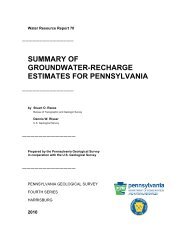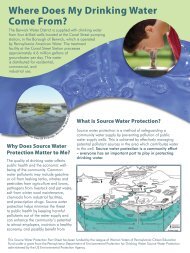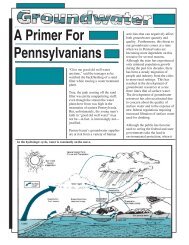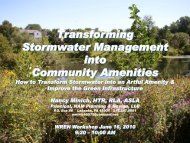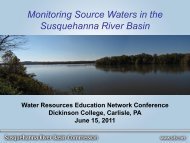NITROGEN POLLUTION: - Hubbard Brook Research Foundation
NITROGEN POLLUTION: - Hubbard Brook Research Foundation
NITROGEN POLLUTION: - Hubbard Brook Research Foundation
Create successful ePaper yourself
Turn your PDF publications into a flip-book with our unique Google optimized e-Paper software.
Nitrogen-related Air Quality Standards<br />
Pollutant Measurement period Standard<br />
Nitrogen dioxide (NO2)Annual mean<br />
0.053 parts per million<br />
Ozone 8-hour average 1 0.08 parts per million<br />
1-hour average 2<br />
0.12 parts per million<br />
Particulate matter Annual mean 50 micro-grams per cubic meter<br />
(10 micrometers or<br />
less in diameter)<br />
24-hour average<br />
150 micro-grams per cubic meter<br />
Particulate matter Annual mean 15 micro-grams per cubic meter<br />
(2.5 micrometers or<br />
less in diameter)<br />
24-hour average<br />
65 micro-grams per cubic meter<br />
1<br />
Current standard<br />
2<br />
Previous standard<br />
Source: U.S. EPA. http://www.epa.gov/airs/criteria.html<br />
For electric utilities, it is estimated that the 1990 Clean Air Act Amendments<br />
(CAAAs) will result in a 1.8 million metric ton reduction in NO x<br />
emissions from<br />
electric utilities by 2010; this is beyond levels that would have occurred without this<br />
legislation. However, the CAAAs did not cap total NO x<br />
emissions from electric utilities<br />
and it is possible that emissions could actually increase in the future as energy<br />
generation increases. Recent Congressional proposals call for additional NO x<br />
emissions reductions from electric utilities that range from 56 percent of 1990 levels<br />
to 75 percent of the projected 2010 levels. Most of these proposals include a cap<br />
on nitrogen oxide emissions.<br />
To evaluate the effect that current and potential future policies may have on<br />
airborne nitrogen pollution in the Northeast, we used the model PnET-BGC<br />
(Photosynthesis and EvapoTranspiration –BioGeoChemical). PnET-BGC is a<br />
mathematical model that incorporates climate data, atmospheric emissions and<br />
deposition together with known forest processes to predict soil and stream conditions<br />
(see Gbondo-Tugbawa et al. 2001). The model can be used as a predictive tool to<br />
evaluate the response of forest ecosystems to changing environmental conditions,<br />
including emission scenarios. We applied the model to two well-studied watersheds<br />
under current climate conditions: the <strong>Hubbard</strong> <strong>Brook</strong> Experimental Forest in New<br />
Hampshire and the Biscuit <strong>Brook</strong> watershed in New York.<br />
Airborne Nitrogen Emission Reduction Scenarios<br />
Sector Scenario Reduction in total<br />
nitrogen emissions<br />
Transportation Reduction in NO x<br />
emissions consistent with EPA Tier 2 regulations. 24%<br />
90% reduction in passenger car emissions beyond EPA Tier 2 standards<br />
achieved by converting the passenger car fleet to superlow emission vehicles. 29%<br />
Electric utilities 75% reduction in NO x<br />
emissions beyond current levels. 10%<br />
Agriculture 34% reduction in ammonia emissions through animal waste treatment. 2%<br />
Integrated 90% reduction in passenger car emissions beyond EPA Tier 2 standards, 75%<br />
reduction in NO x<br />
emissions beyond current levels and 34% reduction in<br />
ammonia emissions. 39%<br />
* Each of these scenarios was also run with an additional 75% reduction in sulfur emissions from electric utilities beyond the emission levels<br />
required in the 1990 Clean Air Act.<br />
PAGE 18



